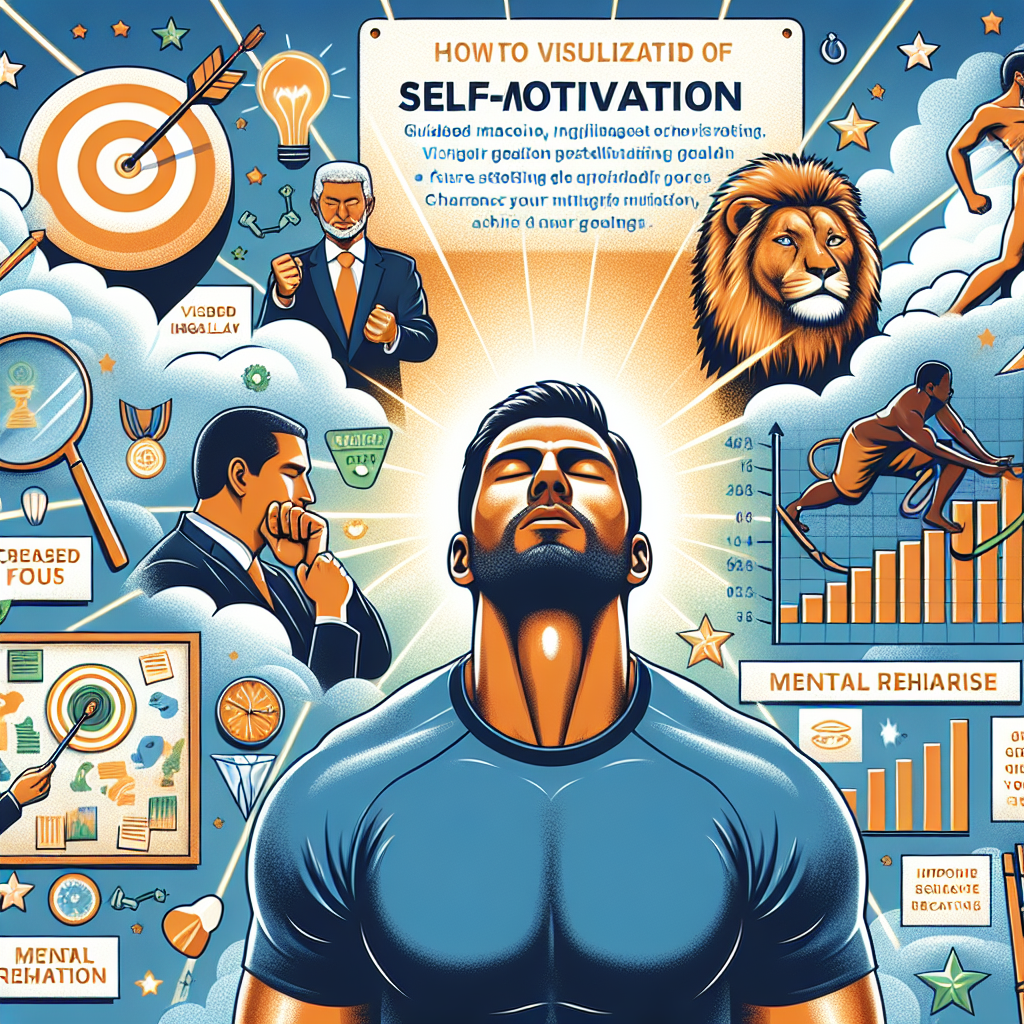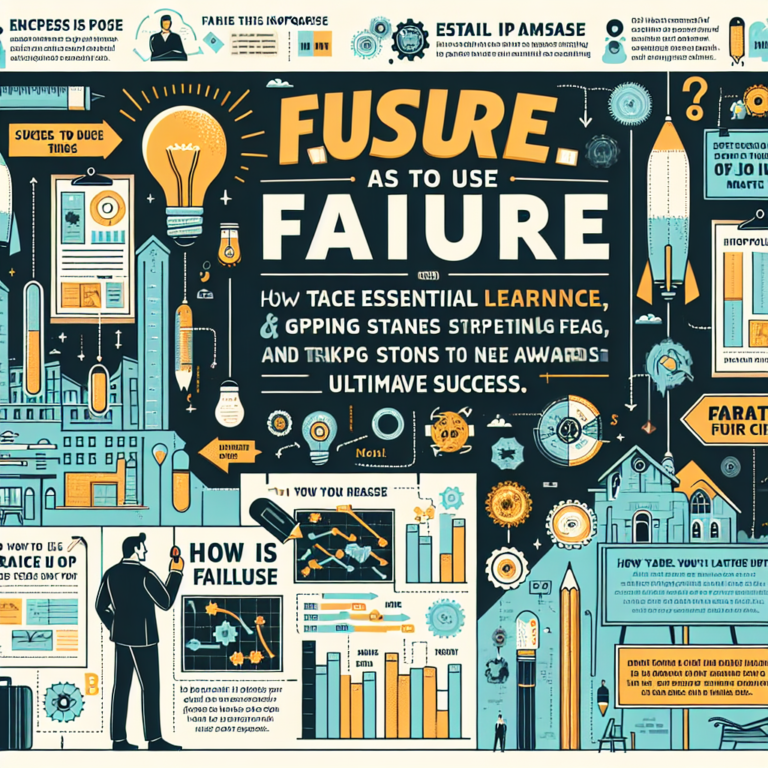How Can Visualization Techniques Improve Self-Motivation?
Imagine a world where you can achieve any goal you set your mind to. A world where your self-motivation is unbreakable and your dreams are within reach. Well, the good news is that this world is not just a fantasy, but a reality that can be attained through the power of visualization techniques. By harnessing the power of your imagination and creating vivid mental images of your desired outcomes, you can boost your self-motivation to new heights. In this article, we will explore how visualization techniques can transform your life and help you become the best version of yourself. So, sit back, relax, and get ready to unleash the power of your mind.

The Power of Visualization
Visualization is a powerful technique that involves creating mental images of specific goals, desires, or outcomes. It is a process where you use your imagination to see, feel, and experience something as if it is already happening. By visualizing, you can tap into the power of your mind to manifest your dreams and enhance your self-motivation.
What is visualization?
Visualization is the practice of creating vivid mental images, using all your senses, to imagine yourself achieving your goals or desired outcomes. It is essentially a mental rehearsal that helps you reinforce positive thoughts and beliefs, connecting your mind and body to the desired outcome. By visualizing, you are programming your subconscious mind to believe in your abilities and take the necessary actions to make your dreams a reality.
How does visualization work?
Visualization works by tapping into the subconscious mind, which is a powerful force that influences our thoughts, feelings, and behaviors. When you consistently visualize your goals or desired outcomes, the subconscious mind starts to accept these mental images as reality. It then seeks to align your thoughts, beliefs, and actions with these images, helping you stay motivated and focused on achieving what you visualize.
Benefits of visualization
The practice of visualization offers numerous benefits for self-motivation:
Increased motivation: Visualization helps ignite your inner motivation by creating a vivid picture of success. When you visualize yourself achieving your goals, you ignite a sense of purpose and drive, propelling you towards taking consistent action.
Enhanced self-belief: Visualization helps build confidence and belief in yourself and your ability to achieve what you desire. As you consistently visualize success, you reinforce positive beliefs, which lead to increased self-efficacy and a greater sense of empowerment.
Improved focus and concentration: When you visualize, your mind becomes laser-focused on your goals. This enhanced focus and concentration help you filter out distractions and stay committed to the actions necessary for success.
Overcoming obstacles and setbacks: Visualization allows you to mentally rehearse overcoming challenges and setbacks. By vividly imagining yourself overcoming obstacles, you strengthen your resilience and develop problem-solving skills, which helps you stay motivated during difficult times.
Understanding Self-Motivation
Self-motivation is an internal drive that directs and energizes your behavior towards achieving your goals. It refers to the ability to motivate yourself without relying on external influences or rewards. Self-motivated individuals possess the determination, perseverance, and enthusiasm needed to accomplish what they set out to do.
What is self-motivation?
Self-motivation is the force that propels you forward, even when faced with obstacles or setbacks. It is the inner drive that pushes you to take action, pursue your goals, and persist in the face of challenges. Self-motivation comes from within, and it is fueled by a combination of passion, purpose, and a belief in your own capabilities.
Why is self-motivation important?
Self-motivation is crucial for achieving success and personal fulfillment. When you are self-motivated, you have the power to take control of your life, set meaningful goals, and work towards achieving them. Self-motivation provides the resilience and determination needed to overcome obstacles and stay focused on your journey, even when faced with difficulties.
Factors influencing self-motivation
Several factors can influence your self-motivation:
Internal locus of control: Believing that you have control over your own actions and outcomes is essential for self-motivation. When you have a strong internal locus of control, you see yourself as the driver of your own destiny, which enhances your motivation to take action.
Clear goals and desires: Having a clear vision of what you want to achieve provides direction and purpose. When you have well-defined goals and desires, your self-motivation is fueled by the desire to bring those visions to life.
Positive mindset: Cultivating a positive mindset is essential for self-motivation. When you maintain a positive outlook, you are better equipped to handle setbacks and challenges, staying motivated despite obstacles.
Supportive environment: Surrounding yourself with supportive individuals who believe in your capabilities can significantly impact your self-motivation. Positive encouragement and reinforcement from others can bolster your belief in yourself, empowering you to stay motivated.
Exploring Visualization Techniques
Visualization techniques offer various methods to harness the power of your imagination and enhance your self-motivation. By incorporating these techniques into your daily life, you can cultivate a strong mental imagery practice that aligns your thoughts, beliefs, and actions with your goals.
Guided imagery
Guided imagery is a technique that involves using audio recordings or scripts to guide your visualization practice. It typically involves listening to a narrator who describes specific scenes, images, and sensations, allowing you to immerse yourself in the visualization experience. Guided imagery can be particularly helpful for beginners or those who find it challenging to create mental images on their own.
Creating vision boards
Vision boards are physical or digital collages that visually represent your goals and desires. By collecting images, quotes, and symbols that correspond to your aspirations, you create a visual representation of your dreams. Displaying your vision board in a prominent place serves as a daily reminder of what you are working towards, enhancing your self-motivation and focus.
Mental rehearsal
Mental rehearsal involves vividly imagining yourself successfully performing a specific task or achieving a desired outcome. By mentally rehearsing the actions and steps required for success, you strengthen your neural pathways and prime your mind for success. Mental rehearsal can be effective for athletes, public speakers, and individuals preparing for challenging situations.
Positive affirmations
Positive affirmations are statements or phrases that are repeated to oneself to reinforce positive beliefs. By incorporating positive affirmations into your visualization practice, you can replace self-doubt and negativity with empowering thoughts and beliefs. Affirmations help reprogram your subconscious mind, strengthening your motivation and self-belief.
How Visualization Enhances Self-Motivation
Visualization serves as a powerful tool for enhancing self-motivation by positively impacting various aspects of your mindset and behavior. Let’s explore how visualization can enhance self-motivation in different ways:
Boosting confidence and belief in oneself
When you consistently visualize yourself accomplishing your goals, you begin to develop a deep sense of confidence and belief in your capabilities. Visualization allows you to see yourself as successful, capable, and deserving of achieving your desires. This heightened confidence strengthens your self-motivation and encourages you to take bold actions towards your goals.
Clarifying goals and desires
Visualization aids in clarifying your goals and desires by helping you define and refine what you truly want. As you spend time visualizing your desired outcomes, you gain clarity on the specific details and aspects that are most important to you. This clarity allows you to set specific, achievable goals that align with your deepest desires, further fueling your self-motivation.
Enhancing focus and concentration
By regularly practicing visualization, you train your mind to focus on your goals and block out distractions. Visualization helps sharpen your focus and concentration, as you immerse yourself in the imagined experience of achieving your desires. This enhanced focus enables you to stay motivated and dedicated to the necessary tasks and actions for success.
Overcoming obstacles and setbacks
The process of visualization allows you to mentally rehearse overcoming obstacles and setbacks, equipping you with the mental resilience necessary to persevere. By vividly imagining yourself successfully navigating challenges, you strengthen your problem-solving skills and your ability to bounce back from setbacks. This resilience enhances your self-motivation by reminding you that obstacles are simply part of the journey to success.
Applying Visualization in Daily Life
To truly harness the power of visualization, it is important to integrate it into your daily life. By making visualization a regular practice, you can maximize its impact on your self-motivation and overall success.
Establishing a visualization practice
Start by setting aside dedicated time each day for visualization. Find a quiet and comfortable space where you can relax and focus. Begin with a few deep breaths to calm your mind and then mentally envision your desired outcomes. Consistency is key, so make visualization a daily habit to reap its full benefits.
Choosing meaningful visualizations
Select visualizations that resonate with your core desires and goals. Visualize not only the end result but also the process of achieving your goals. Engage all your senses as you imagine yourself experiencing success, bringing your visualizations to life in a vivid and emotionally charged way.
Incorporating visualization into routines
Integrate visualization into your existing routines to make it a seamless part of your day. For example, visualize your goals while brushing your teeth in the morning or before going to bed at night. By incorporating visualization into routine activities, you ensure that it becomes a consistent practice that continuously boosts your self-motivation.
Tracking progress and adjusting visualizations
Regularly evaluate your progress and adjust your visualizations accordingly. As you move closer to your goals or encounter new experiences, update your mental images to align with your evolving desires. By tracking your progress and modifying your visualizations, you keep your motivation aligned with your current aspirations.
Visualization Techniques for Different Situations
Visualization techniques can be applied to various areas of your life. Let’s explore how visualization can be used in specific contexts:
Using visualization for fitness and health goals
When working towards fitness and health goals, visualization can be a valuable tool. Visualize yourself engaged in physical activities, feeling strong, and achieving optimal health. See yourself making healthy food choices and enjoying the positive benefits of a balanced lifestyle. By regularly visualizing your ideal fitness and health outcomes, you strengthen your motivation to prioritize your well-being.
Visualization in educational and professional contexts
In educational and professional settings, visualization can enhance performance and goal achievement. Visualize yourself confidently delivering presentations, acing exams, or successfully completing projects. By mentally rehearsing these scenarios, you enhance your self-motivation, reduce anxiety, and increase your chances of success.
Applying visualization for personal development
Visualization can greatly support personal development and self-improvement. Visualize yourself mastering new skills, developing positive habits, or overcoming personal challenges. By visualizing yourself on a continuous journey of growth, you fuel your self-motivation to continually strive for personal excellence.
Harnessing visualization for emotional well-being
Visualization can also be used to enhance emotional well-being. Visualize yourself in calming and peaceful environments, experiencing joy, love, and gratitude. By immersing yourself in these positive emotional states through visualization, you cultivate resilience, inner peace, and increased self-motivation.
Overcoming Common Challenges in Visualization
While visualization is a powerful technique, it is not without its challenges. Here are some common challenges and strategies to overcome them:
Resistance or difficulty in visualization
Some individuals may initially struggle with visualization due to a lack of practice or an overly active mind. To overcome resistance or difficulty, start with short and simple visualizations. Use guided imagery or visualization aids to support your practice. With consistent effort, visualization will become easier and more natural over time.
Dealing with distractions and negative thoughts
Distractions and negative thoughts can interfere with the effectiveness of visualization. Practice mindfulness to cultivate awareness and gently redirect your focus back to your visualizations. Use positive affirmations to counteract negative thoughts and reinforce positive beliefs. Be patient with yourself and seek support from others if needed.
Maintaining consistency in visualization practice
Consistency is crucial for visualization to have a lasting impact on self-motivation. Create a routine and set aside dedicated time for visualization each day. Find accountability partners or join visualization groups to stay motivated and receive support. Remind yourself of the benefits of visualization to maintain your commitment to the practice.
Adapting visualizations to changing circumstances
As your goals and desires evolve, it is important to adapt your visualizations accordingly. Regularly reassess your vision and make adjustments to keep your visualizations aligned with your current aspirations. Embrace flexibility and embrace the process of refining and updating your mental images as you progress on your journey.
Combining Visualization with Other Strategies
While visualization is a powerful technique on its own, it can be further enhanced by combining it with other strategies:
Utilizing affirmations and mantras
Incorporate positive affirmations or mantras during visualization to reinforce empowering beliefs. Repeat affirmations such as “I am capable of achieving my goals” or “I have the power to manifest my dreams” to strengthen your self-motivation and align your mindset with success.
Using goal-setting techniques
Combine visualization with effective goal-setting techniques to enhance motivation. Set SMART (specific, measurable, achievable, relevant, and time-bound) goals and visualize yourself achieving each milestone. By integrating visualization with goal-setting, you create a powerful synergy that fuels your self-motivation and accelerates your progress.
Incorporating mindfulness and meditation
Practice mindfulness and meditation to cultivate presence and mental clarity before engaging in visualization. By calming your mind and focusing on the present moment, you enhance the effectiveness of visualization. Mindfulness and meditation also support self-awareness, which enables you to make intentional choices that align with your goals.
Seeking support from others
Engage in discussions and seek support from like-minded individuals who are also utilizing visualization techniques. Join visualization groups, attend workshops or seek out a mentor who can provide guidance and encouragement. Surrounding yourself with a supportive community enhances motivation and provides valuable insight and inspiration.
Research and Evidence on Visualization for Self-Motivation
Numerous scientific studies and findings support the efficacy of visualization techniques for self-motivation. Research has shown that visualization can enhance performance, boost confidence, and improve overall well-being. Additionally, studies exploring the mind-body connection highlight the impact of visualization on physiological responses and the activation of neural pathways associated with motivation.
Case studies and success stories provide real-life examples of individuals who have achieved remarkable results through the practice of visualization. These stories demonstrate the transformative power of visualization for self-motivation and serve as inspiration for those seeking to harness the technique for their own personal and professional growth.
Ethics and Limitations of Visualization Techniques
While visualization techniques can be highly effective, it is important to consider ethical considerations and recognize their limitations:
Ethical considerations in visualization
Visualization should be practiced ethically, respecting the boundaries and rights of others. Avoid using visualization to manipulate or harm others, and ensure that your visualizations align with values of compassion, empathy, and integrity. Focus on personal growth and success without infringing on the well-being of others.
Recognizing limitations and boundaries
Visualization techniques have certain limitations. While they can enhance self-motivation, they should not be seen as a substitute for action or real-life effort. Visualization is most effective when combined with consistent action and a comprehensive goal-seeking strategy. Recognize that visualization alone cannot guarantee success and be willing to adapt your approach when necessary.
Avoiding unrealistic expectations
Maintain realistic expectations when utilizing visualization techniques. While visualization can enhance self-motivation, it does not guarantee instant or effortless results. Success requires effort, persistence, and resilience. Avoid falling into the trap of expecting immediate outcomes solely from visualization. Instead, embrace the long-term benefits and gradual progress that visualization can offer.
In conclusion, visualization techniques have the power to significantly enhance self-motivation. By leveraging the practice of visualization, individuals can boost their confidence, clarify their goals, enhance focus, and overcome obstacles. Visualization can be applied in various areas of life and combined with other strategies to maximize its impact. While practicing visualization, it is important to respect ethical considerations, recognize limitations, and set realistic expectations. By incorporating visualization into your daily life and staying committed to the practice, you can unlock the true potential of self-motivation and achieve your dreams.







